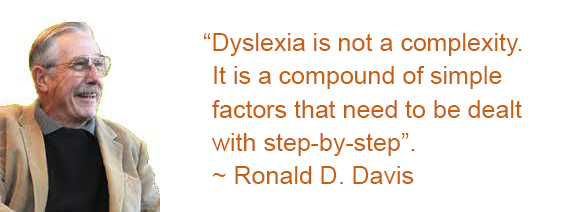Dyslexia
What is Dyslexia?
How Dyslexia “Works”
There are 3 factors that cause dyslexia.
The first of these factors is the ability to think in pictures. Picture thinking, typically at 32 pictures a second, is a lot faster than thinking with the sounds of words (typically 100-200 words per minute). It shows in higher intelligence, creativity and problem solving abilities that picture thinkers exhibit.

The pictures are 3-dimensional and very realistic. The individual can quickly imagine what an object, such as a chair, looks like from in front, behind, above, below – any angle at will. This second factor is not a problem in itself, but when this ability is used to understand 2-dimensional symbols, picture-thinkers become confused.
In its simplest form, a dyslexic can confuse b for d or p or q by looking at it or imagining it from different perspectives. In this way a dyslexic can confuse words like was and saw, become a creative speller, show incorrect grammar with incorrect word order in a sentence, or show illogical thoughts by disordered sentences or paragraphs within an essay.
Because picture thinking is so fast, dyslexics write slower than they can think, miss out parts of the story and become frustrated by the process.
As picture thinkers read, they have a movie going in their imagination. With words like brown horse jumps white fence green paddock, the movie is clear. When they come across words like the over a and into there are no pictures. Typically they skip over or substitute these words. This causes the movie to blip like a poor quality VCR or scratched DVD; too many blips and the video jams.

Often you hear words like ““This is dumb/stupid/boring” because the movie has stopped and there are no pictures in their heads. They can’t understand what they have just read. Eye rubbing, hair pulling, fidgeting and other strategies have helped in the past but don’t always work. The third factor, difficulty dealing with confusion, results in dyslexia.
Consequently, dyslexics learn a myriad of little tricks to help them get by. They spend their days putting their minds through hoops, working many times harder than others to achieve less output. A dyslexic often daydreams as they wait for the feeling of confusion to disappear.

When learning becomes painful, avoidance strategies come to the fore. We see the class clown, the most helpful child, the quiet head-down approach or the naughty child who prefers to be known as that rather than dumb. These solutions and defensive behaviour patterns disable a person’s ability to learn.
When teaching reading, a phonetic method is often used. Dyslexics, however, are less likely to think with the sounds or shapes of words. They are more likely to think with pictures or mental images in a creative and multi-dimensional way that benefits from hands-on learning. Because they don’t think with sounds of words, it is very hard for them to learn by sounding out. That is why phonics often fails with this group of learners.

The Davis™ methods have been developed to utilise the picture thinking ability of dyslexic individuals. During the 30-hour programme, clients are given “tools” and exercises to identify and control confusion, address and eliminate the sources of confusion and allow a relaxed state of focus to be used for learning.
These new strategies quickly replace the old ones as they bring success and improved self-esteem to the student.
Do you want to find out more? Call, text or email Margot to arrange a free initial consultation on 04 478 2208 or 021 673 119 or contact Wellington Learning Solutions




Licensed and certified
by Davis Dyslexia
Association International
Professional services described as Davis™, Davis Dyslexia Correction®, Davis Symbol Mastery™, Davis Orientation Counselling™, Davis Math Mastery™, Davis Attention Mastery™, Dyslexia the Gift™ and Gift of Dyslexia™ may only be provided by persons who are employed by a licensed Davis Specialist, or who are trained and licensed as Davis Facilitators by Davis Dyslexia Association International.
Davis Autism Approach® is a trademark of Ronald D. Davis. Commercial use of this trademark to identify educational, instructional, or therapeutic services requires licensing by the trademark owner. For more information go to Davis Autism International.
